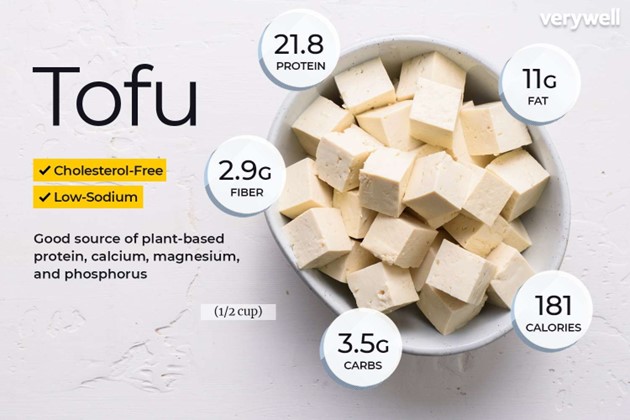A nurse is caring for a client who is at 12 weeks of gestation and is prescribed a high-protein diet. Which of the following foods should the nurse recommend as containing the highest amount of protein?
One cup of oatmeal.
One cup of tofu.
One cup of brown rice.
One cup of kale.
The Correct Answer is B
Choice A reason:
One cup of oatmeal - Oatmeal is a nutritious food, but it does not contain as high a protein content as some other options. While it offers some protein, it is not the best choice for a high-protein diet during pregnancy. Oatmeal is primarily known for its fiber content and complex carbohydrates, which provide sustained energy.
Choice B reason:
 One cup of tofu - Tofu is an excellent source of protein and is a suitable choice for a high- protein diet during pregnancy. Tofu is made from soybeans and is rich in plant-based proteins, making it an ideal option for individuals following a vegetarian or vegan diet as well. Additionally, tofu contains essential amino acids, iron, calcium, and other nutrients beneficial for both the mother and the developing fetus.
One cup of tofu - Tofu is an excellent source of protein and is a suitable choice for a high- protein diet during pregnancy. Tofu is made from soybeans and is rich in plant-based proteins, making it an ideal option for individuals following a vegetarian or vegan diet as well. Additionally, tofu contains essential amino acids, iron, calcium, and other nutrients beneficial for both the mother and the developing fetus.
Choice C reason:
One cup of brown rice - While brown rice is a healthy whole grain and provides some protein, it does not have as high a protein content as tofu. Brown rice is a good source of complex carbohydrates, fiber, vitamins, and minerals, but it may not meet the high protein requirements of a pregnant woman's diet.
Choice D reason:
One cup of kale - Kale is a nutritious leafy green vegetable, but it does not offer a significant amount of protein compared to tofu. It is rich in vitamins, minerals, and antioxidants, making it a valuable addition to a balanced diet. However, for a high-protein diet during pregnancy, other options like tofu are more suitable.
Nursing Test Bank
Naxlex Comprehensive Predictor Exams
Related Questions
Correct Answer is D
Explanation
Choice A reason:
The nurse should not tell the client to lie flat on their back for the duration of the nonstress test. It is essential for pregnant clients to be in a semi-reclining or left lateral position during the test to avoid supine hypotension syndrome. This condition can occur when the weight of the uterus compresses the inferior vena cava, reducing blood flow to the heart and potentially compromising the baby's well-being.
Choice B reason:
The nurse should not instruct the client to lightly brush their palms across their nipples during the test. This statement is not related to the nonstress test procedure. The nonstress test involves monitoring the baby's heart rate in response to its movements, and nipple stimulation is not a standard part of the test.
Choice C reason:
The nurse should not advise the client not to eat or drink anything for 4 hours before the test. It is important for pregnant clients to have adequate nutrition and hydration, especially during the third trimester. Restricting food and drink for such a prolonged period could lead to dehydration and may not be necessary for the test.
Choice D reason:
This is the correct choice. During a nonstress test, the client is connected to a fetal heart rate monitor. They are asked to press a button whenever they feel the baby moving. This allows the healthcare provider to correlate the baby's movements with changes in the heart rate pattern, which helps assess the baby's well-being.
Correct Answer is A
Explanation
Choice A reason:
Hypothermia. Hypothermia refers to a condition where the body temperature drops significantly below the normal range. However, in cases of acute opioid toxicity, the opposite effect is usually observed. Opioids can cause respiratory depression, leading to a decrease in the body's ability to regulate temperature, resulting in hyperthermia, not hypothermia.
Choice B reason:
Hypertension. Acute opioid toxicity typically causes respiratory depression, which can lead to a decrease in blood pressure rather than hypertension. Opioids are central nervous system depressants that slow down the body's vital functions, including heart rate and blood pressure.
Choice C reason:
Diaphoresis. Diaphoresis is the medical term for excessive sweating. While it may occur in some cases of opioid toxicity due to the body's response to stress or increased sympathetic activity, it is not a specific and consistent finding. It is not as characteristic as other symptoms associated with opioid toxicity.
Choice D reason:
Mydriasis. Mydriasis refers to the dilation of the pupils. This is a hallmark sign of opioid toxicity. Opioids can affect the autonomic nervous system, leading to pupillary constriction (miosis) in most cases. However, when opioid toxicity is severe or acute, the pupils may dilate, resulting in mydriasis.
Whether you are a student looking to ace your exams or a practicing nurse seeking to enhance your expertise , our nursing education contents will empower you with the confidence and competence to make a difference in the lives of patients and become a respected leader in the healthcare field.
Visit Naxlex, invest in your future and unlock endless possibilities with our unparalleled nursing education contents today
Report Wrong Answer on the Current Question
Do you disagree with the answer? If yes, what is your expected answer? Explain.
Kindly be descriptive with the issue you are facing.
